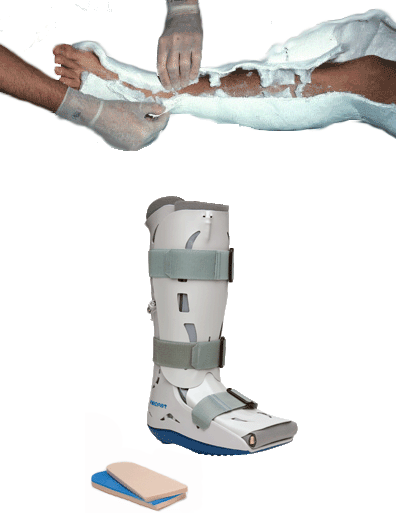
Introduction
Specifically designed to meet the needs of the higher risk diabetic patient, the XP Diabetic Walker System features the XP Diabetic Walker. Similar to the XP Walker™, the XP Diabetic Walker incorporates a high rocker sole for maximum off-loading of the diabetic foot and an innovative dual density insole to help eliminate pressure points. These insoles, when combined with the semi-rigid shell and full aircell coverage, also helps regulate shear stress.
The Walker's shell/aircell/rocker design maximises plantar unloading and provides protection and immobilisation.
A specialised Hand Bulb with Pressure Gauge is included with each System to measure individual aircell compression. This precise measuring ensures regulated aircell inflation for neuropathic patients. The XP Diabetic Walker System is an ideal alternative to total contact casting.
Unlike casting which requires costly and time consuming removal and application during skin and wound examinations, the XP Diabetic Walker can be easily removed and reapplied time after time. The XP Diabetic Walker can be secured closed with the Aircast Brace-Lok™ to help monitor patient progress. Walking Brace Extension Straps are available to increase the strap length by 4" (10 cm).
The Diabetic Replacement Kit (dual density insoles and a spare sock) helps prevent pressure points and therefore pressure sores. This accessory can be ordered seperately.
The IMPAX Replacement Kit (one Impax™ Grid and one Plastizote) allows specifix areas of the sole for example diabetic ulcers to be unloaded. This accessory can be ordered seperately. Each kit comes with one Impax™ Grid and one Plastizote and a Diabetic Walker soc.
Indications
Useful in patients with diabetes or other causes of small vessel disease.
• Achilles tendon repairs
• Stable fractures of the lower leg and ankle
• Acute ATFL ankle injury
• Soft tissue injuries
• Stress fractures of the lower leg and ankle
Information on Ordering
Corresponding Sizes:
Size / UK Men / UK Women
S / 4-5.5 / <4
M / 6-8 / 5.5-7.5
L / 8.5-10 / 8-9.5
XL / >10.5 / >10
Innovations
• An aircell lined shell that maximises plantar unloading, regulates shear stress, and provides protection and immobilisation
• Graduated compression to help reduce oedema
• Multi-aircell support for a total contact fit
• Regulated aircell pressure with a specialised Hand Bulb with pressure guage.
• Instruction sheet to help you measure and fit the brace for your patient.
Pain under Plaster Algorithm
Do you worry as a surgeon each time you put a neuropathic or arteriopathic patient into a plaster cast?
OrthopaedicsandTrauma.com asked Orthopaedic Surgeon, John Hardy to tell us when he preferred to use this brace. John said " I have seen the most awful complications of even the best applied plaster casts in diabetic patients with leg fractures.
The worst complications being pressure sores and ulcers. This system is an ideal alternative to total contact casting."
"Unlike casting which requires costly and time consuming removal and application during skin and wound examinations, the XP Diabetic Walker™ can be easily removed and reapplied time after time. With the additional diligence and care you can offer with regular and easy review of your patients limbs you can avoid the added costs to your health service of managing ulcers in diabetic patients."
"Remember you must never ignore pain in a plaster cast. Localised pain beneath a cast can be investigated by windowing a cast. Cast removal is mandatory immediately if the patient presents with generalised pain."
The XP Diabetic Walker can be secured closed with the Aircast Brace-Lok™ to help monitor patient progress.
Walking Brace Extension Straps are available to increase the strap length by 4" (10 cm).
Arthroscopic Ankle Arthrodesis
Mr Harries, a Consultant Trauma and Orthopaedic Surgeon, said that he used the Aircast XP Diabetic Walker or XP Walker™ after Arthroscopic Ankle Arthrodesis.
Mr Harries said that this was an operation he did for high demand patients with osteoarthritis of the ankle joint alone. He said that the procedure was performed arthroscopically and the joint surfaces held together using 2 crossed percutaneous screws. This he said was a viable option for diabetic patients with a high risk of infection for an open operation. He said that he had recently completed the 100th in his personal series and that he had participated in the series published in 2005 (Winson IG, Robinson DE, Allen PE. Arthroscopic ankle arthrodesis. J Bone Joint Surg Br. 2005 Mar;87(3):343-7.)
Mr Harries said that his postoperative regime included a plaster cast for 2 weeks after surgery. This was removed for suture removal at 2 weeks. Then he said that he prescribed the XP Walker™ as a non-weight bearing cast for 4 weeks. He then allowed his patients to weightbear progressively over the final 6 weeks. He said that unless there were indications he radiographed the ankle at 12 weeks after surgery. If there were signs of delayed union he asks patients to wear their XP Walker™ for longer.